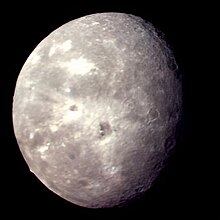Wikijunior:Solar System/Uranus/Oberon

Oberon is a moon of the planet Uranus. It is the outermost of the major moons of Uranus. Oberon was first seen in detail when the spacecraft Voyager 2 passed by Uranus in 1986.
How big is Oberon?
editThis moon is 1523 km across. It is the second largest of the moons of Uranus, and is only slightly smaller than Titania. The total surface has an area that is less than the continent of Australia.
What is its surface like?
editOnly half of this moon has been seen from a close distance, so we only know what that surface is like. The ground looks like it is made of ice with some darker materials. The surface is covered by many craters that were formed when large rocks collided with the moon. It is a very, very cold place that does not have an atmosphere.
How long is a day on Oberon?
editIt takes 13 days and 11 hours for Oberon to complete an orbit around Uranus, just under two weeks.
What is it made of?
editThis moon is made of a mixture of rocks, ice, and other frozen materials.
How much would Oberon's gravity pull on me?
editNewtons describe how hard gravity is pulling you down. On Earth, if you weigh 51 kilograms or 112 pounds, your weight is 500 newtons. We only use newtons for some special purposes, when we are really interested in how hard we push down on something because gravity is pulling us.
Your weight in newtons would be less on Oberon, only about one twenty-eighth what it is on Earth. To find your weight in newtons as you stand on Oberon, just take your weight on Earth, and if that weight is in kilograms, multiply it by 0.35. If that weight is in pounds, divide it by six to get newtons. But then you'll have to add in the weight of your spacesuit as well, because that is pressing down on the surface just like you are.
Who is it named after?
editThe name for this moon was suggested by John Herschel, the son of Sir William Hershel. It was named after the mythical King of the Faeries in William Shakespeare's play A Midsummer Night's Dream. This character was drawn from the legendary history of Britain, and is based on the legends of King Arthur and his times.
How was it discovered?
editIt was discovered by the English astronomer William Herschel on January 11, 1787.